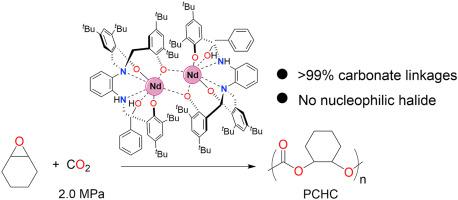Journal of Rare Earths ( IF 5.2 ) Pub Date : 2021-07-15 , DOI: 10.1016/j.jre.2021.07.007 Quanyou Yao 1 , Yongjie Chen 1 , Yaorong Wang 1 , Dan Yuan 1 , Hongpeng You 2 , Yingming Yao 1, 2

|
A series of o-phenylenediamine bridged tris(phenolate) ligand-stabilized rare-earth metal complexes were synthesized and characterized. Lanthanum (complex 1), neodymium (complex 2tBu), and yttrium (complex 3) complexes stabilized by ligand of bulky tert-butyl substituents are mononuclear, whereas neodymium complexes 2Me and 2Cl bearing smaller methyl and chloro substituents are dinuclear, respectively. They were applied in the alternating copolymerization of CO2 and cyclohexene oxide. The addition of benzyl alcohol is beneficial to improving yields (up to 86%) and selectivity of poly(carbonate) (up to 99%). Stoichiometric reaction of benzyl alcohol with rare-earth metal complexes 1 and 2tBu results in formation of complexes 4 and 5 as dinuclear complexes with benzyl alcohol coordination, which was confirmed via single crystal X-ray diffraction analysis, and nuclear magnetic resonance (NMR) spectroscopy (for 4). Complex 5 shows equally good activity and selectivity of that of complex 2tBu and benzyl alcohol, consolidating that complex 5 is indeed generated during polymerization. The neodymium tris(phenolate) 5 is one of the few examples of rare-earth metal complex as a single-component initiator for copolymerization of epoxide and CO2. Matrix-assisted laser desorption ionization-time of flight (MALDI-TOF) mass spectrometry analysis proves benzyloxy group as the chain end. 1H NMR monitoring suggests that the insertion of CO2 may be the first step in the growth of the polymer chain.
中文翻译:

由邻苯二胺桥联三(酚盐)配体稳定的稀土金属配合物引发的CO2和氧化环己烯的交替共聚
合成并表征了一系列邻苯二胺桥联三(酚)配体稳定的稀土金属配合物。镧(络合物1)、钕(络合物2 t Bu)和钇(络合物3)络合物由大叔丁基取代基的配体稳定是单核的,而带有较小甲基和氯取代基的钕络合物2 Me和2 Cl是双核的,分别。应用于CO 2的交替共聚和环己烯氧化物。添加苯甲醇有利于提高聚碳酸酯的收率(高达 86%)和选择性(高达 99%)。苄醇与稀土金属配合物1和2 t Bu的化学计量反应导致配合物4和5与苄醇配位形成双核配合物,这通过单晶 X 射线衍射分析和核磁共振 (NMR) 得到证实) 光谱学(对于4)。络合物5表现出与络合物2 t Bu和苯甲醇同样好的活性和选择性,巩固了络合物5确实是在聚合过程中产生的。三(酚)钕5是稀土金属络合物作为单组分引发剂用于环氧化物和CO 2共聚的少数例子之一。基质辅助激光解吸电离飞行时间(MALDI-TOF)质谱分析证明苄氧基为链端。1 H NMR 监测表明,CO 2的插入可能是聚合物链增长的第一步。











































 京公网安备 11010802027423号
京公网安备 11010802027423号